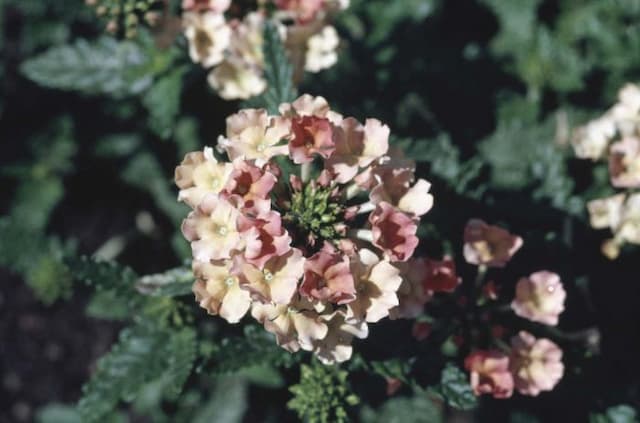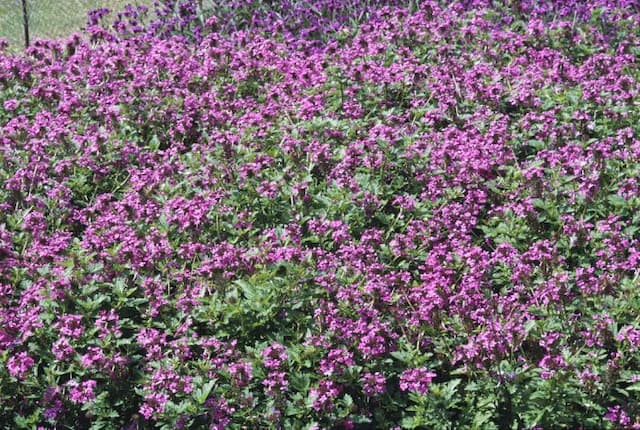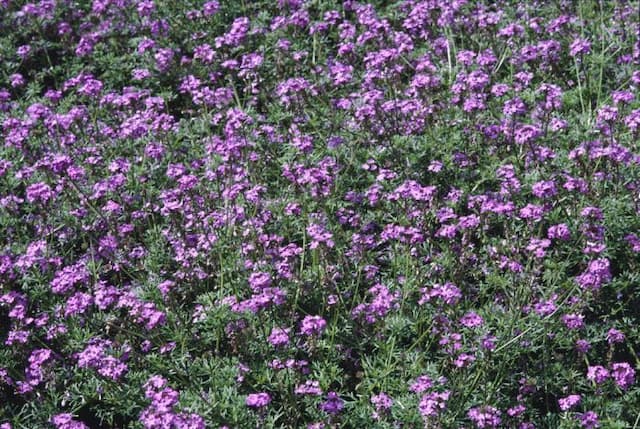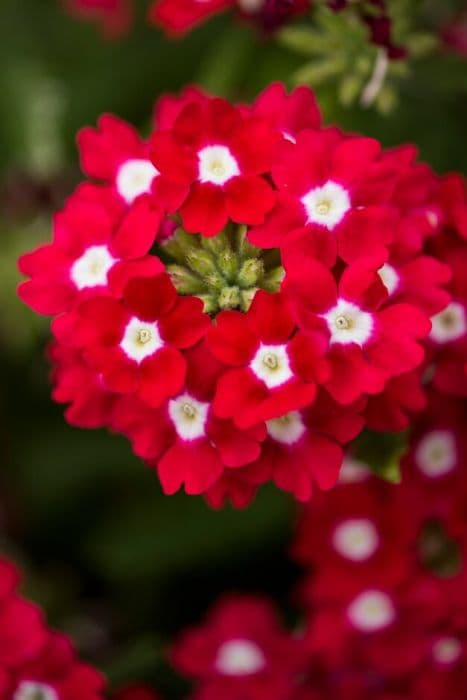Slender vervain Verbena rigida 'Santos'
ABOUT
The plant known as the rigid verbena 'Santos' is a visually captivating perennial known for its rich floral display. It boasts a dense clustering of vivid purple flowers, which are small, tubular, and arranged in tight spikes. The blossoms create a striking contrast against the dark green, narrow, lance-shaped leaves that adorn the plant. The foliage, somewhat rough in texture, is held on stiff, upright stems which contribute to the upright and tidy overall form of this variety. The flowers of rigid verbena 'Santos' are favored for their ability to attract butterflies and other pollinators, making this variety not only beautiful but also beneficial for ecosystem health. The plant exudes a sense of vibrancy and is often admired for the continuous bloom it provides from early summer to the first frost, adding long-lasting color and interest to gardens and landscapes.
About this plant
 Names
NamesFamily
Verbenaceae.
Synonyms
Rigid Verbena, Slender Vervain, Tubular Vervain, Hardy Verbena, Santos Verbena.
Common names
Verbena rigida, Verbena venosa.
 Toxicity
ToxicityTo humans
Verbena is not generally considered highly toxic to humans, but it can cause mild discomfort if ingested. It may lead to vomiting, diarrhea, and abdominal pain in some people. Sensitivity varies from person to person, so while some may experience no adverse effects, others may be more susceptible to the plant's mild irritants. It is always advisable to avoid ingesting parts of this plant and supervise children and pets to prevent accidental consumption.
To pets
Verbena is considered non-toxic to pets, and there are no well-documented cases of poisoning in animals such as dogs and cats. However, it's always possible that individual pets might have a sensitivity or allergic reaction to the plant that could lead to mild gastrointestinal upset should they ingest it. While it is not thought to be dangerously toxic, it's still wise to prevent pets from eating plants to avoid the potential for stomach discomfort or more serious issues related to individual sensitivity.
 Characteristics
CharacteristicsLife cycle
Perennials
Foliage type
Deciduous
Color of leaves
Green
Flower color
Purple
Height
1-2 feet (30-60 cm)
Spread
1-2 feet (30-60 cm)
Plant type
Herb
Hardiness zones
7
Native area
South America
Benefits
 General Benefits
General Benefits- Attracts Pollinators: Verbena rigida 'Santos' is known to attract bees, butterflies, and other beneficial insects, which aids in pollination of gardens.
- Drought Tolerance: Once established, the plant is quite drought-resistant, making it suitable for xeriscaping or low-water gardens.
- Long Blooming: It offers a long blooming season from early summer to frost, providing extended color and interest in the garden.
- Low Maintenance: This plant requires minimal care once established, thriving with just occasional watering and the removal of spent flowers.
- Landscape Versatility: It can be used in a variety of landscape settings, including borders, rock gardens, and as a groundcover.
- Vibrant Color: The bright purple flowers add a striking pop of color to garden spaces.
- Fast Growing: Verbena rigida 'Santos' grows quickly, which allows it to establish and cover bare spots in the garden swiftly.
 Medical Properties
Medical PropertiesThis plant is not used for medical purposes.
 Air-purifying Qualities
Air-purifying QualitiesThis plant is not specifically known for air purifying qualities.
 Other Uses
Other Uses- Verbena can be used in potpourri mixes to add a sweet, lemony fragrance, which is released when its leaves are crushed.
- As a natural fabric dye, the blossoms of Verbena can offer varying shades of blue and green depending on the mordants used.
- Its flowers attract hummingbirds and butterflies, making it ideal for inclusion in wildlife gardens where the goal is to support local ecosystems.
- Gardeners use Verbena in companion planting to attract pollinators that benefit vegetable crops and fruit trees.
- Used in sachets, dried Verbena can be placed in drawers and closets as a natural moth repellent to protect clothing.
- It can serve as a flavoring agent for beverages and desserts, infusing them with a subtle lemony essence.
- When dried and burnt, Verbena serves as a natural incense, releasing a calming scent that is often used in aromatherapy.
- Verbena’s essential oil can be a component in natural perfumes, offering a fresh and invigorating scent profile.
- The dried stems and flowers of Verbena can be incorporated into homemade wreaths and floral arrangements for decoration.
- In crafting, Verbena flowers can be pressed and used in botanical paper-making or to create decorative bookmarks.
Interesting Facts
 Feng Shui
Feng ShuiThe Verbena is not used in Feng Shui practice.
 Zodiac Sign Compitability
Zodiac Sign CompitabilityThe Verbena is not used in astrology practice.
 Plant Symbolism
Plant Symbolism- Healing: Verbena, commonly referred to as Vervain or Verbena rigida 'Santos', has traditionally been associated with healing properties, thought to help alleviate various ailments both physically and emotionally.
- Protection: This plant has also been used in various cultures as a symbol for protection against harm and evil.
- Purification: It’s believed that Verbena can clear negative energy, purifying an area or a person's aura, leading many to use it in purification rituals.
- Harmony: Known to foster harmony and peace, Verbena is often employed in spells and practices meant to bring tranquility to a household or relationship.
- Love: In some traditions, Verbena is a symbol of love and is used in various love spells or as a charm to ensure the affection of a loved one.
- Creativity: Thought to stimulate creativity and inspiration, artists or writers may turn to this herb to open the mind and enhance creative flow.
- Determination: Leading by its rigid structure, Verbena rigida 'Santos' can represent determination and the will to persevere through challenges.
 Water
WaterThe rigid verbena prefers moderate watering. During the growing season, water the plant thoroughly once a week with about 1-2 gallons, depending on the weather conditions and soil moisture levels. It's essential to allow the soil to dry out between waterings to avoid overwatering, which can lead to root rot. In hotter, drier climates or during periods of drought, you might need to water more frequently. During the winter months, reduce watering as the plant's water needs decrease. Always check the soil moisture with your finger before watering to ensure it's not too wet or too dry.
 Light
LightRigid verbena thrives best in full sunlight, where it can receive at least six hours of direct sunlight daily. The ideal spot for this plant is in a location where it is exposed to unfiltered sunlight throughout the day. However, in extremely hot climates, it may benefit from some light afternoon shade to prevent scorching.
 Temperature
TemperatureRigid verbena performs well in a wide range of temperatures but prefers a climate where nighttime temperatures don't drop below 50°F and daytime temperatures are consistently between 65°F and 85°F. It can tolerate temperatures up to 90°F without significant stress. However, it is not frost-tolerant, and exposure to temperatures below 50°F can damage the plant.
 Pruning
PruningPruning rigid verbena helps to encourage bushier growth and continuous flowering. Deadhead spent flowers regularly to promote new blooms. Perform a more substantial prune in early spring or after the last frost by cutting back by one-third to stimulate fresh growth. It's not necessary to prune during the winter, but cleaning up any dead or damaged stems is beneficial.
 Cleaning
CleaningAs needed
 Soil
SoilRigid Verbena (Verbena rigida 'Santos') thrives in well-draining soil rich in organic matter with a pH of 5.8 to 7.2. A mix of garden soil, compost, and perlite or sand would create an ideal environment for this plant, ensuring good drainage and sufficient nutrients.
 Repotting
RepottingRigid Verbena does not typically require frequent repotting as it is often treated as an annual. However, if grown as a perennial, repotting every 2-3 years in spring can rejuvenate its growth.
 Humidity & Misting
Humidity & MistingRigid Verbena prefers average ambient humidity and does not require special humidity conditions. It is quite tolerant of dry conditions once established.
 Suitable locations
Suitable locationsIndoor
Ensure full sun, well-draining soil, and moderate watering for Rigid Verbena.
Outdoor
Plant in full sun, in well-draining soil; water regularly, less when mature.
Hardiness zone
Rigid Verbena is suited for USDA zones 7-11.
 Life cycle
Life cycleVerbena rigida 'Santos', commonly known as rigid verbena or Santos vervain, begins its life cycle as a seed, which germinates in late spring when soil temperatures warm. Upon germination, it develops a root system and a rosette of ground-level leaves. As it matures, rigid verbena sends up erect, branching stems and foliage, followed by spikes of vibrant purple flowers that bloom from midsummer to fall. The flowers are highly attractive to pollinators, which assist in the plant's reproductive process through pollination. After flowering, it produces small, nut-like fruits that contain seeds, completing the cycle as these seeds are dispersed by wind, water, or animals. In temperate climates, the plant may die back to the ground with the onset of winter, but it can re-emerge from its roots or self-seed the following spring if conditions are favorable.
 Propogation
PropogationPropogation time
Spring-summer
The most popular method of propagation for Verbena rigida 'Santos', commonly known as rigid verbena, is through seed. The best time to sow seeds is late winter to early spring, when the temperatures start to rise enough for seed germination. Seeds should be scattered lightly onto the surface of well-draining, moist potting soil and pressed in gently, but not completely covered, as they need light to germinate effectively. Then they are usually kept at a temperature around 70 to 75 degrees Fahrenheit (21 to 24 degrees Celsius). Germination typically occurs within 2 to 3 weeks. After the seedlings have developed a few true leaves and are big enough to handle, they can be transplanted into individual pots or in the garden, being sure to give them sufficient space for growth.


![Vervain [Donalena Lavender Grace]](/_next/image?url=https%3A%2F%2Fplants-admin.emdemapps.com%2Fimages%2Fplants%2F%2Fimages%2F604b575c837e7.png&w=640&q=75)





![Vervain [Endurascape Pink Bicolor]](/_next/image?url=https%3A%2F%2Fplants-admin.emdemapps.com%2Fimages%2Fplants%2F%2Fimages%2F604b594e749b0.png&w=640&q=75)
